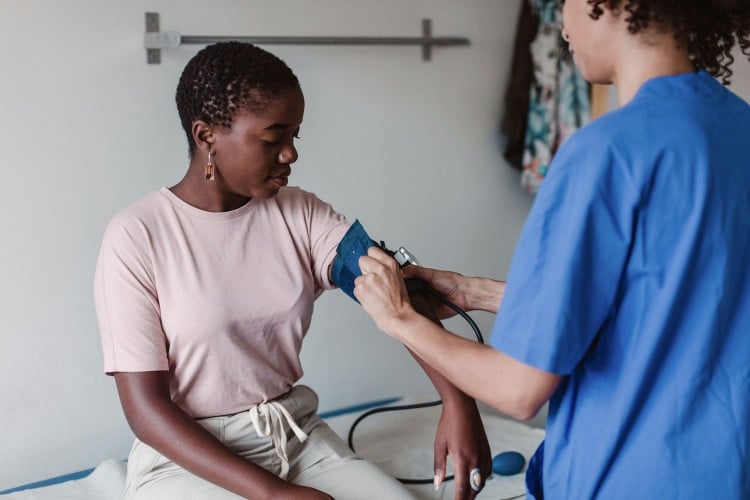Blood Pressure Cuff Size Could Lead to Inaccurate Readings
- Using incorrectly sized blood pressure cuffs can lead to significantly inaccurate blood pressure readings, especially for individuals with larger arms, new research shows.
- Incorrect blood pressure readings can result in misdiagnosis and inappropriate treatment decisions, researchers said.
- It's crucial to consider arm size when choosing a cuff and to follow recommended protocols for accurate blood pressure measurements.

Maskot/Getty Images
A person's blood pressure can provide essential insights into their health, but new research finds that something as seemingly minor as the fit of an arm cuff can throw these crucial readings out of whack.
For the study, published earlier this month in JAMA Internal Medicine, researchers used varying-sized cuffs to test the blood pressure of nearly 200 adults. They found that using a standard blood pressure cuff regardless of a person’s arm size led to “strikingly inaccurate” blood pressure readings—especially for people with larger arms.
These results emphasize the need to individualize blood pressure cuffs, the researchers concluded.
“Clinical practice guidelines recommend selecting an appropriately sized blood pressure cuff based on arm size prior to measuring blood pressure,” lead study author Junichi Ishigami, MD, MPH, an assistant scientist of epidemiology at Johns Hopkins Bloomberg School of Public Health, told Health. “However, this procedure is often overlooked—due to time constraints and lack of cuffs with different sizes—and a regular adult blood pressure cuff is used routinely for all individuals.”
Most People Don't Know What a Normal or Healthy Blood Pressure Is, Study Shows
The Importance of Blood Pressure Readings
“Proper blood pressure screening at the provider’s office is critical,” Nadine M. Aktan, PhD, assistant dean of advanced practice at the Rutgers University School of Nursing, told Health.
Blood pressure tests measure the pressure of blood pushing against artery walls. A low reading can indicate an issue if it’s accompanied by symptoms such as dizziness or nausea, according to the American Heart Association. High blood pressure, or hypertension, signals a higher-than-normal risk of developing severe health complications such as a heart attack or stroke.
What Blood Pressure Readings Mean
The first number in a blood pressure reading is systolic blood pressure, which shows how much pressure your blood exerts against the artery walls when the heart contracts. The second number, diastolic blood pressure, indicates the pressure exerted when the heart is at rest.
- A normal blood pressure level is less than 120/80 mm Hg.
- High blood pressure is considered 140/90 mm Hg or higher.
- Low blood pressure is considered less than 90/60 mm Hg.
“A lot of health decisions are made on that blood pressure reading in the office,” Jennifer Wong, MD, a cardiologist and medical director of non-invasive cardiology at the MemorialCare Heart and Vascular Institute at Orange Coast Medical Center in Fountain Valley, Calif., told Health.
A high blood pressure reading would usually prompt a doctor to recommend a patient begin taking blood pressure at home, she said. Because blood pressure may be highest in the office (a phenomenon called white coat hypertension), home recordings can give the patient and doctor a better idea of what’s really happening with blood pressure and how it might be changing over time, Thomas Boyden, MD, Corewell Health medical director for preventive cardiology and cardiac rehabilitation, told Health.
Having an incorrect reading can be a big deal, Dr. Boyden stressed, especially if results are consistently off. “Incorrect blood pressure readings can lead to over-treatment, which can lead to medication side effects, or under-treatment which puts an individual at higher risk of heart attack, stroke, heart failure, atrial fibrillation, and other organ damage,” he said.
How an Incorrect Cuff Size Affects Blood Pressure Readings
To look at the impact of “miscuffing” on blood pressure readings, the researchers recruited 195 people in Baltimore and measured their upper arm circumference to determine their appropriate cuff size. Researchers then had participants walk around for two minutes before getting their pressure tested using three different-sized cuffs: one that was too small, one that was too large, and one that was their size. Participants repeated the process three times.
Using a too-small or too-large cuff size resulted in “clinically and statistically significant lower and higher BP readings, respectively,” the researchers wrote.
People who used a standard cuff when they needed a smaller one had readings that were, on average, about 2% lower than they should have been. Meanwhile, those who used a standard cuff size instead of a large one had readings artificially inflated by an average of 4%. Participants who needed an extra-large cuff had an even greater percentage error, on average: about 14% too high.
“These findings are a good reminder that we should be looking at a patient’s size when we choose a blood pressure cuff and, ideally, should be measuring them,” said Dr. Wong.
What Is a Healthy Blood Pressure Reading—And How Can You Keep Yours in a Normal Range?
How to Know When a Cuff Size is Right For You
Unless you have expertise in blood pressure cuffs, it’s often tough to know what you’re getting at the doctor’s office, said Dr. Ishigami. Therefore, “it’s best if you ask your doctor which blood pressure cuff size is right for you,” he advised.
It’s especially important to say something if you feel like the cuff doesn’t fit, Aktan pointed out. “In general, the blood pressure cuff should cover about 75% to 100% of the distance around the upper arm and be wide enough to cover from 40% to 80% of the distance from the elbow to the shoulder,” she explained.
When it comes to buying a blood pressure cuff, Aktan suggested measuring the circumference of your arm in centimeters and choosing the next size up if one matches your exact arm size or you fall between sizes. “If you measured 35 centimeters and you’re choosing between a cuff that is 32 or 37 centimeters, you would go with the 37 centimeters,” she said.
A pharmacist can help if you’re buying a cuff at a pharmacy, said Dr. Ishigami, and the doctor who recommended taking your blood pressure at home can also measure your arm and suggest a size.
Signs and Symptoms of High Blood Pressure
Other Factors That Influence Blood Pressure Readings
Other factors besides an ill-fitting cuff can throw off your reading, Rigved Tadwalkar, MD, a board-certified cardiologist at Providence Saint John’s Health Center in Santa Monica, Calif., told Health. They include what kind of activity you did before the reading, your positioning during the test, any recent caffeine consumption, and what he called the “classic reason” for a higher-than-normal reading: anxiety, either over the test or something else.
To make sure you’re getting the most representative reading possible, the Centers for Disease Control and Prevention recommends:
- Not eating or drinking anything 30 minutes before the test
- Emptying your bladder before your reading
- Sitting in a comfortable chair with your back supported for at least five minutes before your reading
- Putting both feet flat on the ground and keeping your legs uncrossed
- Resting your arm with the cuff on a table at chest height
- Putting the cuff against your bare skin, not over your clothes
- Not talking while your blood pressure is being measured
If you get one or several blood pressure readings that seem to stray from your norm, talk to a healthcare provider about your concerns. They can work with you to dig deeper into why the reading may be off.








